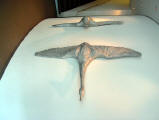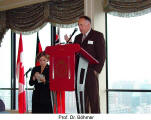
Ties between countries
Art and culture are natural carriers for exchange between nations. Perhaps that is why collaborations in that respect have become also political vehicles, much like marriages between royal houses were in the past. Both create bonds. The question might be: Which ones last longer? Since political alliances change frequently on this planet and even civilisations die, politics is not the obvious long-term survivor. Yet we know that what artists and artisans have created can still be admired thousands of years later if politics and wars have not destroyed what mother nature left untouched. Much like a rhythm can rock down the ages so can patterns and designs still fascinate after thousands of years and become symbols of ideas and ideals.
Each time defines itself through its artists and is all the more valuable when the work creates images that reflect not only the civilisation’s past and present, but also especially when it dreams its future.
Sometimes trends are being defined in innovative ways, an analysis is offered as to the current values of mankind and the relationship to the environment and the technology that imprints the society.
 Such
a presentation was offered immediately after the Film Festival was over by
the Toronto Goethe Institute. Sponsored and arranged by the Icelandic
Consulate and other Icelandic institutions sculptress Steinum
Thorarinsdottir explored such a relationship of man and his technology. With
very clear concepts and symbolic values she depicts mankind as something
living, thinking and separate from technology but also as something that has
become symbiotic with these new
Such
a presentation was offered immediately after the Film Festival was over by
the Toronto Goethe Institute. Sponsored and arranged by the Icelandic
Consulate and other Icelandic institutions sculptress Steinum
Thorarinsdottir explored such a relationship of man and his technology. With
very clear concepts and symbolic values she depicts mankind as something
living, thinking and separate from technology but also as something that has
become symbiotic with these new
 technologies.
Individuality versus sameness, creative thought versus electronics. Dreams
of flight and freedom are as obvious as the singular universe of an
individual, which only stops to exist when plugged into technology.
technologies.
Individuality versus sameness, creative thought versus electronics. Dreams
of flight and freedom are as obvious as the singular universe of an
individual, which only stops to exist when plugged into technology.
 This
presentation of sculptures warns us of what might (be)come. The gap between
us is narrowed because we are all subject to the same pressures in this
global village, whether we live in Iceland or Europe or Canada.
This
presentation of sculptures warns us of what might (be)come. The gap between
us is narrowed because we are all subject to the same pressures in this
global village, whether we live in Iceland or Europe or Canada.
This was an excellent way to bridge the distance between nations and create cultural awareness of one another.
The Goethe Institute always has a diverse program to support these efforts. Check it out and call 416-593-5257 for current programs that include concerts and film presentations as well.
Political bridges
 Having
a different agenda but nevertheless a bridging effort was the visit of a
trade delegation from Sachsen–Anhalt, a minuscule entity with great
traditions within the array of German Laender. Three million people had to
learn a lot after the two Germanys grew together, as much as Professor Dr.
Böhmer, now President of the Bundesrat of the Federal Republic of Germany,
who addressed an interested crowd of local business people at a luncheon
arranged by the German
Having
a different agenda but nevertheless a bridging effort was the visit of a
trade delegation from Sachsen–Anhalt, a minuscule entity with great
traditions within the array of German Laender. Three million people had to
learn a lot after the two Germanys grew together, as much as Professor Dr.
Böhmer, now President of the Bundesrat of the Federal Republic of Germany,
who addressed an interested crowd of local business people at a luncheon
arranged by the German
 Canadian
Chamber of Commerce and Trade and the Toronto chapter of the Business and
Professional Association. Dr. Böhmer was a medical doctor before he entered
politics. We suggested that the two fields had very little in common and a
change from one to the other could be described as walk from a wheat field
into a jungle. "Except one," he said. "In politics as in medicine one must
be able to make important decisions fast, almost instantly to save the
patient." In that respect he feels he was extremely well prepared for
politics, yet everything else was indeed new territory and also quite
different from the political structure he was used to from the familiar East
German model. But it appears that he is very adaptable. He understands the
need to expand and look for solutions. Thus this fishing expedition in
Canada.
Canadian
Chamber of Commerce and Trade and the Toronto chapter of the Business and
Professional Association. Dr. Böhmer was a medical doctor before he entered
politics. We suggested that the two fields had very little in common and a
change from one to the other could be described as walk from a wheat field
into a jungle. "Except one," he said. "In politics as in medicine one must
be able to make important decisions fast, almost instantly to save the
patient." In that respect he feels he was extremely well prepared for
politics, yet everything else was indeed new territory and also quite
different from the political structure he was used to from the familiar East
German model. But it appears that he is very adaptable. He understands the
need to expand and look for solutions. Thus this fishing expedition in
Canada.
 At
the luncheon as at the reception in the evening convened by Deputy Consul
General Marianne Bath in the Park Hyatt Hotel in Toronto he was accessible
and spoke of the need to learn and adjust an outlook that might be coloured
by an Atlas that might not have had the correct scale to appreciate
correctly what is out there. He noticed that we do not take our problems as
seriously as Germans do at home and was resolved to find a different
approach to that too upon his arrival back in Germany.
At
the luncheon as at the reception in the evening convened by Deputy Consul
General Marianne Bath in the Park Hyatt Hotel in Toronto he was accessible
and spoke of the need to learn and adjust an outlook that might be coloured
by an Atlas that might not have had the correct scale to appreciate
correctly what is out there. He noticed that we do not take our problems as
seriously as Germans do at home and was resolved to find a different
approach to that too upon his arrival back in Germany.
He was very interested in the perceptions we have of Germany in Canada, even as Germans living here, and we were happy to help him out with our findings and observations.
It was an interesting encounter with a politician who is quite a different breed than the usual variety and eminently suited to make new friends for Germany.
![Prof. Dr. Wolfgang Böhmer (l.) at 24 Sussex Dr. with Jean Chrétien [photo: Jonathon Harrington]](310c-Böhmer-und-Chretien_small.jpg) While
the trade delegation stayed in Toronto and met with other business entities
Prof. Dr. Böhmer was on his way to Ottawa where all the honours of a
statesman were bestowed on him. He met with our Governor General Adrian
Clarkson, the Prime Minister Jean Chrétien and other parliamentarians after
which he flew home to another parliament session,
While
the trade delegation stayed in Toronto and met with other business entities
Prof. Dr. Böhmer was on his way to Ottawa where all the honours of a
statesman were bestowed on him. He met with our Governor General Adrian
Clarkson, the Prime Minister Jean Chrétien and other parliamentarians after
which he flew home to another parliament session,
 hopefully
with a new and less serious outlook and lots of new contacts and ties for
his home base of Sachsen-Anhalt as well as for Germany.
hopefully
with a new and less serious outlook and lots of new contacts and ties for
his home base of Sachsen-Anhalt as well as for Germany.
The bridge building continues with the second annual German Festival during the entire month of October in Toronto, Hamilton and Kitchener.
Until next time
Sybille Forster-Rentmeister
Comments to: sfr@echoworld.com

